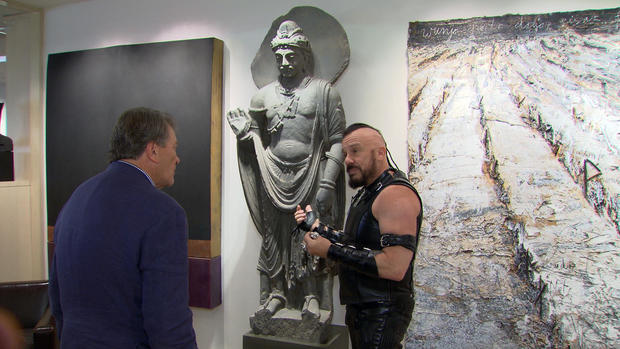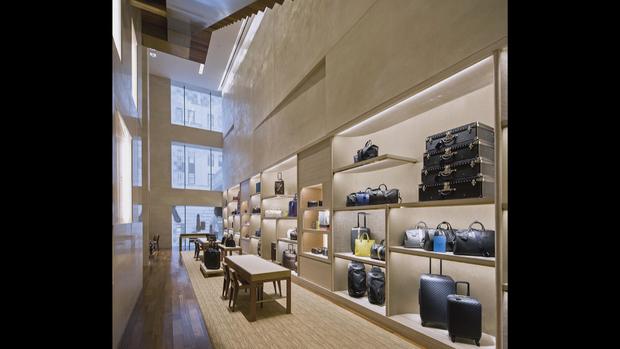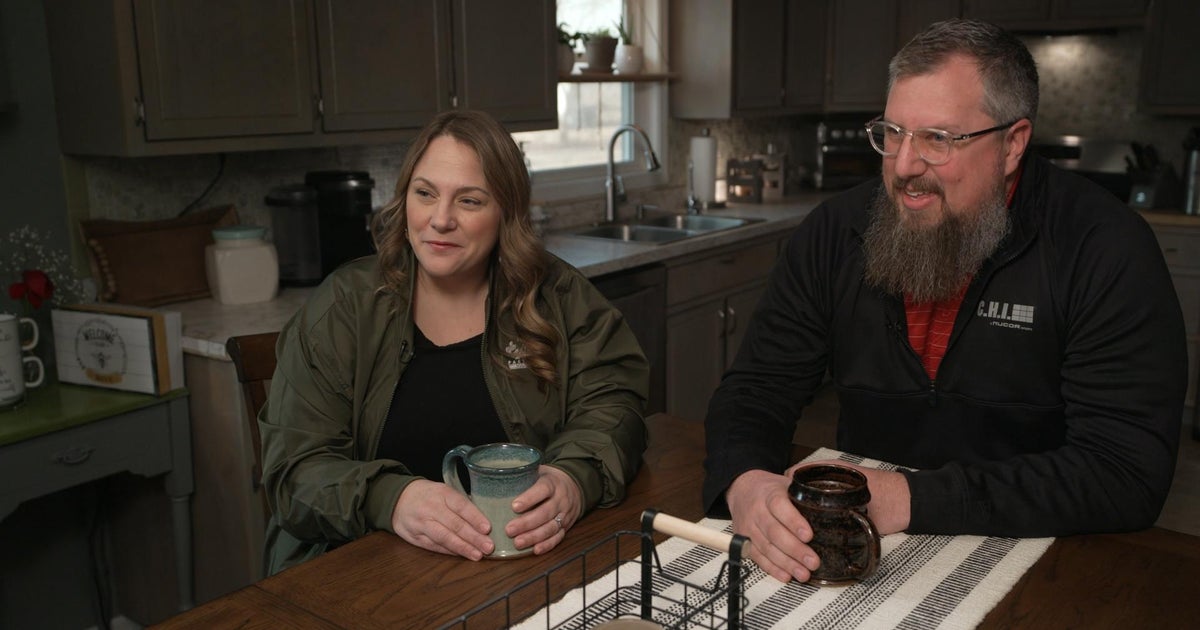Architect Peter Marino calls his tattooed biker look "a decoy"
Over the years, we've done stories on all sorts of people, but to our knowledge, we have never done one on a late middle-aged man who dresses in biker gear with visible tattoos and sterling-silver skull rings. And certainly not one who also happens to be fluent in French and advanced mathematics. No, Peter Marino is one-of-a-kind.
And as we first reported this spring, if you follow the worlds of art, architecture, and high fashion you probably know he is a serious player in all of them -- a tastemaker for some of the richest, most sophisticated people in the world. Many of whom would agree that Marino's appearance is actually one of the least interesting things about him.
At first glance, you might mistake him for the bouncer at a leather bar, a professional wrestler, or the front man for a Village People tribute band. But here in Paris, at a reception for the Biennale, one of the oldest art and antique fairs in the world….
"Thinking out-of-the-box goes along with dressing out-of-the-box and living out-of-the-box."
Peter Marino: Hi! How are you, Madame Reza?
…Peter Marino is instantly recognized…
Woman: I'm a big fan of yours.
Peter Marino: Oh, thank you, thank you, Madam.
…And actively courted by people you might think would run the other way.
Man: Master!
But behind the threatening, keep-your-distance façade is an amusing, ironic, highly accomplished artist and businessman, with a sensitive soul. His talents are demonstrated in the beauty and breadth of his design work and architecture, and contradict his carefully considered public image of a beast on a motorcycle.
Steve Kroft: People make first judgments about people based on their appearance. There's an old saying, "The clothes make the man."
Peter Marino: How about the older statement, "Don't judge a book by its cover"?
Steve Kroft: But you want people to judge you by this look. This is your look.
Peter Marino: Absolutely not. It's a decoy.
Steve Kroft: A decoy.
Peter Marino: Sure. Would you think you're talking to a bright architect looking at a guy like me?
Steve Kroft: Do you still know calculus and trig and all of that stuff?
Peter Marino: Had to. Had to get my license, and you gotta keep your license up-to-date. You have to take 18 credits a year. That's the hardest part. You gotta keep taking courses. Dude, they don't let you forget it. Yeah.
The arts and fashion worlds have always had a high tolerance for eccentricity: take Tom Wolfe and his white suits, Karl Lagerfeld's dark glasses and fingerless gloves, and Lady Gaga.
There is no question that Marino's signature look has made him one of a handful of living architects actually recognized by the media.
Steve Kroft: One of your good friends said that you like the shock value, like you like the fact that people say "What's with him?"
Peter Marino: I like more the fact that I like to think out-of-the-box. Thinking out-of-the-box goes along with dressing out-of-the-box and living out-of-the-box. If you want to come up with a really original design idea and you want to capture a whole new design direction, perhaps the best way to arrive at that is not by acting and thinking and doing like everybody else. That's all.
"If you want to come up with a really original design idea and you want to capture a whole new design direction, perhaps the best way to arrive at that is not by acting and thinking and doing like everybody else."
If the getup was simply a publicity gimmick, Marino would have disappeared decades ago. His work would not be regularly featured in Architectural Digest and other glossy magazines. And the firm that bears his name would not be occupying two floors and 16,000 square feet of some of the most-expensive office space in New York, which is furnished with museum-quality artwork all from Marino's private collection: paintings and sculpture, modern art and antiquities all juxtaposed in perfect harmony.
Steve Kroft: This is quite a room.
Peter Marino: Yeah.
Steve Kroft: Quite a reception area. What is this piece?
Peter Marino: This is 2003, Anselm Kiefer.
Steve Kroft: And this?
Peter Marino: This is Gandharan, third-century AD.
Steve Kroft: Gandharan?
Peter Marino: Yeah, it's from Gandhara. And it's the region just on the Silk Road where the Chinese culture and the Indian culture just met with the Greek culture.
Art is at the center of Marino's universe, and his knowledge of it is encyclopedic. He not only collects it, he curates it and commissions it for his projects. It covers nearly every inch of wall space, and is here, he says, not to impress his clients, but to inspire the staff of 150 designers and architects with whom he turns out between 50 and a hundred projects a year.
Peter Marino: Design-wise, I look at everything. If I don't personally design it, I'll review it. I'm kind of creative director of the firm.
Steve Kroft: You're a bit of a control freak.
Peter Marino: You'd have to ask the staff for that.
Steve Kroft: Bordering on the tyrannical.
Peter Marino: You'd have to confirm that with the staff.
Steve Kroft: Do you see yourself as a tyrannical boss?
Peter Marino: No. I only care about the work and I'm not tyrannical personally in any way, shape, or form. But I am absolutely passionate about the quality of the work.
And so are the clients that can afford him, who mostly come from the world's wealthiest one hundredth of one percent, encompassing the glitterati and the Emirati.
"I only care about the work and I'm not tyrannical personally in any way, shape, or form. But I am absolutely passionate about the quality of the work."
Peter Marino: This is a residential project we're building on the top of Los Angeles. It's a large site assembled from over seven homes. And this is in construction.
Steve Kroft: And what is this structure?
Peter Marino: This is for the subterranean parking.
Steve Kroft: And this is a private home?
Peter Marino: This is a private home. It's—
Steve Kroft: And you-- can you tell us anything about the owner?
Peter Marino: No.
It's Marino's default answer. He won't comment about his clients, which have reportedly included the likes of multibillionaires David Geffen and David Koch, as well as Gisele Bündchen and Tom Brady. This home in Milan, we're told, was done for Giorgio Armani.
Peter Marino: I like my clients. All of my clients say, "Peter. You're talented. But, your best virtue is your discretion." They really don't want to be talked about.
This Hampton's beach house was designed for a young, hedge-fund manager and his wife; and this ski chalet in Lebanon with ocean views for a Swiss banker.
But for every private client Marino won't speak about, somewhere in the world he is unveiling a project that is the talk of the town.
Like BOONTHESHOP, a multi-brand luxury shopping center that takes up two downtown blocks in Seoul, South Korea. No expense was spared.
Peter Marino: It's all-white Greek marble. These are trapezoids-- like they fell to space. It's an interesting building 'cause the entire inside is rough concrete.
He says it was built for the family that controls Samsung.
Steve Kroft: I mean, it's fair to say you work with some of the richest people in the world, right?
Peter Marino: Yes.
Steve Kroft: Do they need to be treated a different way?
Peter Marino: If they need to be treated a different way, no one's told me. I remember when I was meeting certain royal families if I had to behave a certain way. Like, you better tell me what I'm supposed to say and do. They went, the way you look, it doesn't really matter. Just be yourself. And I went OK, OK.
Those partnerships can produce some unusual optics. We watched this meeting with Sidney Toledano, the CEO of Christian Dior, who is one of Marino's biggest clients and biggest fans. They have collaborated on dozens of Dior boutiques all over the world. Toledano is used to working with big egos and difficult people, but says Marino is not one of them.
Sidney Toledano: I never had the impression that he was complicated. Because he always finds the solution. And he's very professional.
Steve Kroft: How important is he to your business? Or how important has he been to your business?
Sidney Toledano: He has been key. Don't tell him.
Steve Kroft: He understands Dior.
Sidney Toledano: He understands Dior.
Toledano sees Marino's look as an artistic presentation of his personality...he doesn't even mind the fact that Marino also works for most of his competitors.
Peter Marino: This is a new building we'll be building for Chanel.
Steve Kroft: So you've got Chanel up here. You've got—
Peter Marino: Louis Vuitton.
Steve Kroft: Louis Vuitton. Who else?
Peter Marino: Dior, Hublot, Zegna-- we do Zegna world-wide. We do Bulgari. We're opening a new one in London in December. Fendi, if you just saw the Fendi on 57th and Madison.
For decades, Marino has been the architect of choice for nearly all of the top fashion designers and luxury brands and is widely credited with reimagining the use of retail space, moving away from boxy department stores and into elegant boutiques. His work lines the most conspicuous avenues and boulevards of the world. It's a third of his business. Every store is unique, and each one distills the essence and the look of the company it was built for: a sense of travel and luxury for Louis Vuitton, the timeless classic look for Chanel.
Steve Kroft: How did you get them to all come to you?
Peter Marino: It's the old question, "Oh, why do they all go to you?" Steve, would you go to a knee doctor who had done two knee operations if you need an operation or one who had done 300 successfully? Who would you go to? That's why they come to me.
Marino's work ethic and personality are rooted in Queens, the New York neighborhood where he was born 67 years ago, the only son in a middle-class Italian family. In high school, he excelled in art and graduated from Cornell University in 1971 with a degree in architecture.
He learned the trade from the very best serving apprenticeships with I.M. Pei and Skidmore, Owings and Merrill. But he picked up the ways of the wealthy, and the value of celebrity from another master, artist Andy Warhol, who always considered business one of the finer forms of art.
Steve Kroft: He certainly knew how to get attention.
Peter Marino: The blonde wig. Dude, that was so good. The blonde wig, that's pretty hard to beat.
Marino did some early work for Warhol and hung out at his New York studio called 'The Factory', which was a magnet for music and movie stars, socialites and royalty. Bob Colacello was the editor of Warhol's Interview Magazine when Marino first walked through the door.
Steve Kroft: What was he like?
Bob Colacello: He had little bowties and he was very properly dressed, you know, and he was funny. He was talented. You could see that right away.
Colacello, now a contributing editor at Vanity Fair magazine, and Isabel Rattazzi, a former model and longtime friend of Marino, think he has changed very little from those ironic factory days of Campbell soup cans, and pop-art parodies of fame.
Bob Colacello: Peter fed right into that. I mean, we were all on the same sort of wavelength, ya know.
Steve Kroft: Tongue-in-cheek.
Bob Colacello: Tongue-in-cheek. A lot of what we were doing was very tongue-in-cheek. Peter, I think, is still very tongue-in-cheek.
Isabel Rattazzi: Totally. He's enjoying it. It's a way to have fun -- at other people's expenses sometimes. I think Peter deep down, more than anything, is an artist. He has an incredible sense of aesthetics. He loves beauty and anything, and art and music.
It's on display at Marino's 12-acre estate where every summer there is a lavish party for friends to introduce young and up-and-coming classical musicians. It's hosted by Peter and Jane Trapnell, his WASPy wife of 33 years, a charming and accomplished costume designer who friends say is an essential part of the equation.
Peter Marino: She's too smart to be interviewed.
Steve Kroft: But you've been married a long time?
Peter Marino: Thirty-three years, yeah. Yeah, it's great.
Steve Kroft: You don't look like the perfect couple, if you know what I mean.
Peter Marino: It's a good marriage because each of us is what we are, allows the other one to be themselves and appreciates each other for the right reason. You know, it's rare that you'll find two people who don't try to change the other person and let everyone be what they are.
Steve Kroft: What's this?
The only other constant in Marino's life, as you may have guessed, are motorcycles. His latest prominently displayed on the project board.
Peter Marino: This is my Super Duke K.T.M. 1290. It's very fast. You're supposed to say, "Does Jane sit on the back? Haha."
Steve Kroft: Does Jane sit on the back, haha?
Peter Marino: Absolutely not. She's in the back of a car and driver with the two dogs.
Marino finds cars claustrophobic. He has a half a dozen bikes, has ridden them all over the country and regularly uses them to commute between New York and his home on Long Island. It's his release, and the core of his identity, alone on the road, where he can take in the air and the light and the space…all part of living life outside-the-box.
Produced by Michael Karzis. Vanessa Fica, associate producer.














